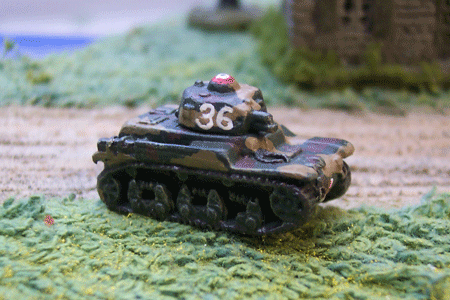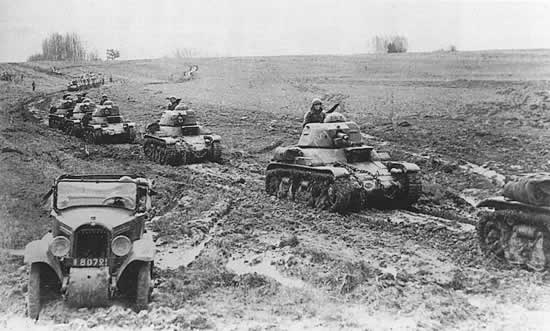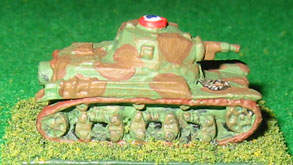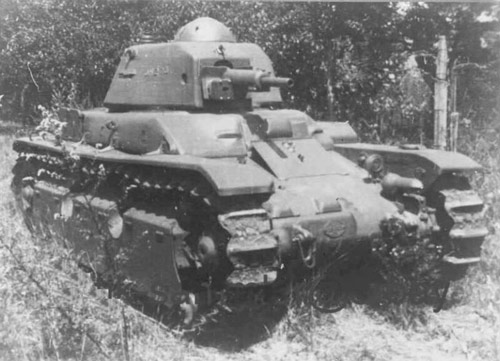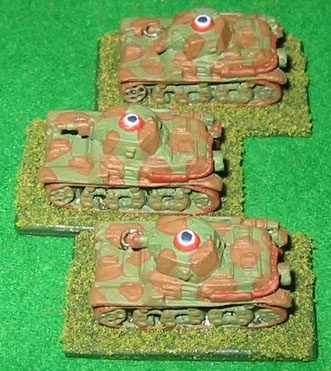|
Renault R 35, R 39 and R 40DescriptionThe Renault R 35 was a light infantry-support tank that entered service with the French army in 1936. It was intended to replace the WW1 vintage FT-17 tank, but not all were so replaced. With over 1,000 vehicles, the R 35 was the most numerous French tank in service in 1940. Starting in 1939, a few of these tanks were equipped with the longer SA38 gun and called R 39. Production of an improved model, the R 40, was started in 1940.
DevelopmentThe development plan of 1926 called for a cheap mass-produced light tank to replace the Renault FT-17. Renault developed the Char D1 to fulfil these requirements, but it was neither cheap nor particularly light (being classed as a medium tank). Following the combined exercises of 1932 and 1933, a plan was created inviting French industry to tender designs. Seventeen companies responded, five submitted prototypes of which three were taken into production: Hotchkiss H 35, Renault R 35 and the FCM 36. There was great rivalry between Hotchkiss and Renault, and in the end the Hotchkiss tank was adopted by the cavalry and the Renault tank by the infantry. The first prototype was manufactured by Renault at the end of 1934 and was based upon Renault's AMR 35. An initial order was placed in May 1935 for 300 examples under the name of char léger modéle 1935-R (R-35), the first of which entered service in June 1936. The R 35 was a light tank designed for use by the infantry just as the Hotchkiss H 35 was designed for the cavalry. The Hotchkiss and the Renault were rather alike in appearance, but can easily be told apart; 6 wheels on the Hotchiss and 5 on the Renault. As would be expected of an infantry tank, the R 35 had better armour protection but a slower speed than the H 39. The R 35 had an APX-R turret armed with the short barrelled 37mm SA18 gun.
Development R 39It was decided that the R 35 needed a better anti-tank capability and in 1939 the R 35 mle 1939 (often abriviated to R 39) replaced the R 35. The R 39 was identical to the R 35 except that it had an APX-R1 turret armed with the longer barrelled 37mm SA38 which had a better anti-tank capability. A total of 350 SA38 guns were installed in the R 39, H 35 and H 39; this being a very small percentage of the available tanks, and generally only enough to equip the platoon leader's vehicle.
Development R 40Development of the R 35 continued and in April 1940 production started of the R 35 mle 1940 (often abriviated to R 40). It was developed by the Atelier de Construction d’Issy-les-Moulineaux (AMX). The R 40 had the long 37mm in APX-R1 turret. It also had a new and better suspension giving a higher top speed and a better cross country performance and was protected by armoured skirting plates. Some R 40 tanks had unditching tails like those on the old Renault FT-17. Unlike the earlier R 35 and R 39, the R 40 had radios installed. Very few were produced before the war ended. No example of the the R 40 survives, so technical details are hard to find and contradictory. The technical data given below is the best I can surmise.
OperationThe commander entered the vehicle by a hatch in the back of the turret. Once in the vehicle, he stood on the floor with his top half in the turret. The commander was very overworked in the one-man turret. Apart from directing the driver and keeping in touch with other tanks in his unit (by flags) the commander was also the main gunner and loader. So in action he would have his head in the cupola directing the driver, he would then have to spot the target and jump down into the turret when he would load with the correct ammunition, rotate the turret by hand onto the target, peer through the gun-sight and set the range, finally fire the gun. The turret had a cupola where most other tanks would have a turret hatch as well as three episcopes in the turret walls. The commander could not raise his head out of the turret and thus had a more restricted view than was possible for German tank commanders who often when into battle so. When captured and used by the German Army the cupola was modified by cutting away the top and installing a two-door hatch. This gave the commander much improved visibility. The driver sat in the hull on the left, the right half and rear of which was taken up by the engine and transmission. He had a hatch in front of him which was usually left open when the tank moved behind the lines but which would have been suicidal to have open in combat when he relied on an observation slit and a episcope which necessitated detailed instructions from the commander. Being intended for an infantry support role, these tanks were mostly equipped with HE rounds, with only enough AP rounds to be able to defend themselves against enemy tanks (approx 12 AP rounds). The battalions assigned to the DCRs had almost half their rounds AP because of their role against enemy tanks. 843 captured tanks were taken over by the Germans, being used among other things as artillery tractors and ammunition carriers (without their turrets) or as self-propelled anti-tank gun mounts. They were also used to train tank drivers; it was one such training unit that on D-Day was among the first to oppose the US airborne landings near Sainte-Mère-Église. They supported an infantry counterattack and penetrated as far as thee command post of the 1st Battalion 505th Parachute Infantry Regiment before being destroyed by bazooka fire.
RadioThe R 35 and R 39 at had no radio, except for the 24th BCC which was part of the 4th DCR. All R 40 tanks had radios installed. These ER 54 mle 1938 radios was especially designed for use in light tanks and were a modified version of the infantry's ER 40 with an effective voice range of 800m. It is not sure how effective these radios were, there being no radio operator, they just added to the over-worked tank commander's heavy burden. DeploymentThe Renault R 35 light tanks normally equipped the independant tank battalions (BCC), these being spread throughout the armies for infantry support duties. Because there were insuficient Hotchkiss tanks, two battalions of R 35 tanks were posted to Reserve Armoured Divisions (DCR) . 10th May 1940When the Germans's attacked the French army had the following Renault R 35 (including R 39) tanks on active service. 900 were in France and 125 abroad. There were no R 40 tanks in service on 10th May.
During the fighting the following tanks were added in May.
The following tanks were added in June.
Technical Data
| ||||||||||||||||||||||||||||||||||||||||||||||||||||||||||||||||||||||||||||||||||||||||||||||||||||||||||||||||||||||||||||||||||||||||||||||||||||||||


